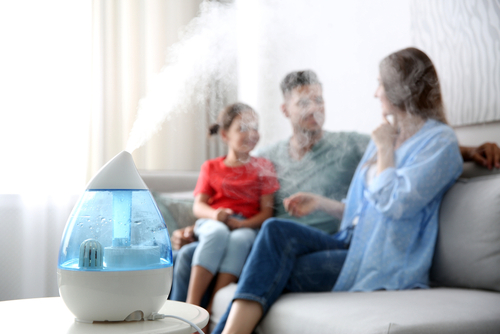Written on: December 9, 2019
 Humidity is the amount of water vapor in the air. When we think about humidity, we tend to associate it with hot days and how insufferable it can make the summertime. However, humidity isn’t just a seasonal nuisance that frizzes your hair and makes you sweat. Paying attention to how much or little moisture you have in your home is crucial to your health and your home.
Humidity is the amount of water vapor in the air. When we think about humidity, we tend to associate it with hot days and how insufferable it can make the summertime. However, humidity isn’t just a seasonal nuisance that frizzes your hair and makes you sweat. Paying attention to how much or little moisture you have in your home is crucial to your health and your home.
Learn why monitoring your humidity is important, how to check your home’s level, and what steps you can take to regulate the water vapor for comfortable, safe living.
When temperatures drop in the winter, the moisture gets sucked out of the air. The moisture also gets sucked out of your skin and body, making it feel tight and dry.
Heating systems in your home worsen the problem because they cause the air to absorb any form of moisture they can. Often, that means anybody in your home becomes the sufferer.
Low humidity in the winter creates:
Low humidity can also inflame and dry out the mucous membrane lining in your respiratory tract, which increases the risk of a cold, flu, and other infections.
The effects of low moisture can also take a toll on the items in your home. If the air in your home craves moisture, you may start to notice the splitting of wood floors or chipping of paint from your walls, which are two common locations that hold onto water vapor.
High humidity during winter comes with a host of problems for your health and home as well.
With too much moisture in the air, you may notice:
Not only are these symptoms problematic to a homeowner because they will cost a pretty penny to repair, but they also come with another set of health issues to consider.
High humidity is the leading cause of mold and mildew growth in a home and can exacerbate — or create — asthma and allergy problems for your loved ones.
Too high, too low — what’s the right level? How do you know how much humidity is in your home?
To combat a home with too high or low humidity, keep your indoor humidity range between 40% and 60%.
There are a few ways you can check the level of humidity during winter in your home:
Not all homes’ HVAC systems have a form of built-in humidity control. If your system doesn’t, you’ll need to find a solution that helps balance the water vapor levels in your home.
A cheap, effective and quick fix is buying a portable humidifier. These can be purchased for under $50 and offer immediate relief for small, dry rooms.
If you need a fix for the entire area of your home, it may be best to invest in a whole-home humidifier. High-quality residential humidifiers connect directly to your home heating system and can control the humidity levels throughout the entire home.
Alternative options to a humidifier:
Keeping the water vapor levels consistent, and within the recommended range of 40% and 60% will keep you safe, comfortable and happy this winter season.
Looking for more tips to keep your home comfortable and efficient this winter? Check out these great resources: